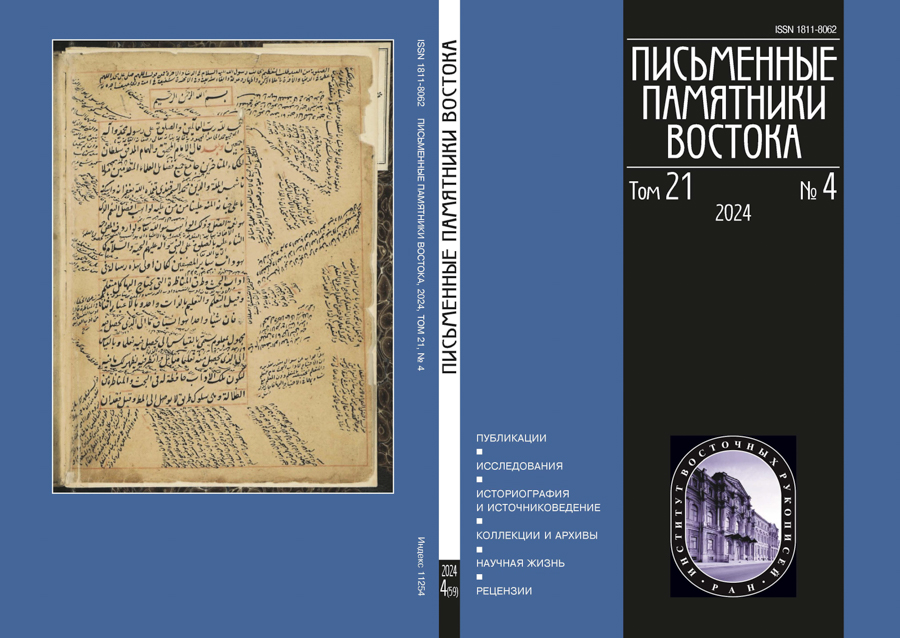Саранча в клинописной графике: об интерпретации сочетания BURU5v.mušen во фрагменте «Ассирийского сонника» Sm.2073
- Авторы: Лопатин М.Д.1
-
Учреждения:
- Санкт-Петербургский государственный университет
- Выпуск: Том 21, № 4 (2024)
- Страницы: 37-46
- Раздел: Исследования
- Статья опубликована: 15.12.2024
- URL: https://journals.eco-vector.com/1811-8062/article/view/635715
- DOI: https://doi.org/10.55512/WMO635715
- ID: 635715
Цитировать
Полный текст
Аннотация
Во фрагменте «Ассирийского сонника» Sm.2073 при перечислении различных супов в качестве ингредиента упоминается некое животное, записанное в клинописи с помощью сочетания BURU5v.mušen, с использованием графического варианта BURU5v (ḪU.ERIM) вместо BURU5 (NAM.ERIM) и детерминатива птицы или летающего существа .mušen. Возможны три интерпретации данной шумерограммы: акк. iṣṣūru «(мелкая) птица», erbu «саранча» или āribu «ворон, ворона». Анализ контекстов употребления данного сочетания в клинописных памятниках I тыс. до н.э. показывает, что использование того или иного графического варианта знака или наличие детерминатива не говорят в пользу ни одного из вариантов. В связи с этим наиболее приемлемой представляется интерпретация BURU5v.mušen как акк. erbu «саранча», поскольку это животное, в отличие от āribu, широко засвидетельствовано как продукт питания, в то время как iṣṣūru в подобных контекстах выписывается с помощью другой шумерограммы.
Ключевые слова
Об авторах
Матвей Денисович Лопатин
Санкт-Петербургский государственный университет
Автор, ответственный за переписку.
Email: m.lopatin@spbu.ru
ORCID iD: 0009-0009-5648-5653
ассистент кафедры Древнего Востока Восточного факультета СПбГУ
Россия, Санкт-ПетербургСписок литературы
- Attinger 1993 — Attinger P. Eléments de linguistique sumérienne. La construction de du11/e/di «dire». Freiburg; Göttingen: Editions Universitaires Fribourg Suisse; Vandenhoeck und Ruprecht, 1993.
- Black 1996 — Black J. The Imagery of Birds in Sumerian Poetry // Mesopotamian Poetic Language: Sumerian and Akkadian. Groningen: Styx, 1996. P. 23–46.
- Borger 2004 — Borger R. Mesopotamisches Zeichenlexikon. Münster: Ugarit-Verlag, 2004.
- CAD — The Assyrian Dictionary of the Oriental Institute of the University of Chicago / The University of Chicago. Vol. A1–Z. Chicago, 1956–2010.
- Bottéro 1995 — Bottéro J. Textes culinaires Mésopotamiens. Mesopotamian Culinary Texts. Winona Lake: Eisenbrauns, 1995.
- Cohen 1981 — Cohen M.E. Sumerian Hymnology: The Eršemma. Cincinnati: Hebrew Union College, 1981.
- Freedman 2017 — Freedman S.M. If a City is Set on Height. Vol. 3. Winona Lake: Eisenbrauns, 2017.
- Geller 2016 — Geller M.J. Healing Magic and Evil Demons. Boston; Berlin: De Gruyter, 2016.
- Landsberger 1934 — Landsberger B. Die Fauna des alten Mesopotamien nach der 14. Tafel der Serie ḪAR-ra = ḫubullu. Leipzig: Hirzel, 1934.
- Landsberger 1937 — Landsberger B. Die Serie anna ittišu (MSL I). Rome: Sumptibus Pontifici Instituti Biblici, 1937.
- Landsberger 1962 — Landsberger B. The Fauna of Ancient Mesopotamia. Second Part: ḪAR-ra = ḫubullu Tablets XIV and XVIII (MSL VIII/2). Rome: Pontificum Institutum Biblicum, 1962.
- Lion, Michel 1997 — Lion B., Michel C. Criquets et autres insectes à Mari // MARI. 1997. Vol. 8. P. 707–724.
- Oppenheim 1956 — Oppenheim A.L. The Interpretation of Dreams in the Ancient Near East. With a Translation of an Assyrian Dream-Book // Transactions of the American Philosophical Society. 1956. Vol. 46. No. 3. P. 179–373.
- Radner 2004 — Radner K. Fressen und gefressen werden: Heuschrecken als Katastrophe und Delikatesse im Alten Vorderen Orient // Die Welt des Orients. 2004. Vol. 34. S. 7–22.
- Schwemer 1998 — Schwemer D. Akkadische Rituale aus Ḫattuša. Die Sammeltafel KBo XXXVI 29 und verwandte Fragmente. Heidelberg: Winter-Verlag, 1998.
- Veldhuis 2004 — Veldhuis N. Religion, Literature, and Scholarship: The Sumerian Composition Nanše and the Birds, with a Catalogue of Sumerian Bird Names. Leiden; Boston: Brill; Styx, 2004.
Дополнительные файлы








